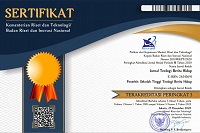Kesalehan atau Kebenaran: Analisis Terjemahan "kol-sidqotenu" dalam Yesaya 64:6
DOI:
https://doi.org/10.38189/jan.v4i2.664Keywords:
Filthy rags, Menstruation, Righteousness, Piety, SinAbstract
Isaiah 64:6, which states that "all our righteousness" is like filthy rags, has been the subject of debate and discussion in Christian theology. This journal aims to explore the concept of righteousness as a condition for human salvation in interpreting this verse. The journal begins by conducting an in-depth analysis of Isaiah 64:6, highlighting keywords such as "filthy rags, menstruation, righteousness, or piety," as well as the textual context within prophetic writings. In this analysis, I argue that human righteousness plays a crucial role in salvation. I describe how righteousness, as a manifestation of humility and repentance, can be the first step in seeking the grace of God and faith in Jesus Christ. Over time, this journal elaborates on how righteousness can become a determining factor in the relationship between humans and God. The goal of this journal is to convey the idea that human righteousness can be a prerequisite that leads people into the embrace of God's grace. It is an effort to delve into the meaning and role of righteousness in Christian theology and to provide a perspective that supports the notion that righteousness is a key factor in the journey toward salvation.References
Ben-Noun, Liubov Louba. “What Is the Biblical Attitude towards Personal Hygiene during Vaginal Bleeding?†European journal of obstetrics, gynecology, and reproductive biology 106 1 (2003): 99–101.
Clark, Gillian. “Rod, Line and Net: Augustine on the Limits of Diversity.†Studies in Church History 43 (March 2007): 80–99.
DiFransico, Lesley. “‘He Will Cast Their Sins into the Depths of the Sea . . .’ Exodus Allusions and the Personification of Sin in Micah 7:7-20.†Vetus Testamentum 67, no. 2 (2017): 187–203.
Edwards, Jonathan. Sinners in the Hands of an Angry God. Edited by Wilson H Kimnach, Kenneth P Minkema, and Caleb J D Maskell. New Haven: Yale University Press, 2010.
Eliyahu, Eyal Ben. “The Rabbinic Polemic against Sanctification of Sites.†Journal for the Study of Judaism 40, no. 2 (2009): 260–280.
Goodman, M. “Chapter Four. The Temple in First-Century CE Judaism.†47–58. Leiden, The Netherlands: Brill, 2007.
Guterman, Mark A. “Observance of the Laws of Family Purity in Modern–Orthodox Judaism.†Archives of Sexual Behavior 37 (2008): 340–345.
Heskett, Randall. “The City, Destruction, and Native Israelite Genres.†In Reading the Book of Isaiah: Destruction and Lament in the Holy Cities, 31–48. New York: Palgrave Macmillan US, 2011.
Isbell, Charles David. “The Limmûdîm in the Book of Isaiah.†Journal for the Study of the Old Testament 34, no. 1 (September 2009): 99–109.
John C. Endres. “Tobit: A Review Note.†The Expository Times 113, no. 2 (November 2001): 54.
de Jong, Matthijs J. “Isaiah among the Ancient Near Eastern Prophets,†2007.
Kamali, Mohammad Hashim. “The Principle of Original Cleanliness (Taharah).†Edited by Mohammad Hashim Kamali. Shariah and the Halal Industry (August 2021): 49–56.
Kim, Hyuk-ki. “The Role of Metaphors in the Interpretation of a Prophetic Discourse: A Linguistic Analysis on Isaiah 40-55,†2012.
Kratz, Reinhard G. “Israel in the Book of Isaiah.†Journal for the Study of the Old Testament 31, no. 1 (September 2006): 103–128.
Meyers, Carol. “Procreation, Production, and Protection: Male-Female Balance in Early Israel.†Journal of the American Academy of Religion LI, no. 4 (December 1983): 569–594.
Navarro, Jaime, Juan J Sendra, and Salvador Muñoz. “The Western Latin Church as a Place for Music and Preaching: An Acoustic Assessment.†Applied Acoustics 70, no. 6 (2009): 781–789.
Ngong, David Tonghou. “Theology as the Construction of Piety: A Critique of the Theology of Inculturation and the Pentecostalization of African Christianity.†Journal of Pentecostal Theology 21 (2012): 344–362.
O’Callaghan, Paul. “Luther and ‘Sola Gratia’: The Rapport Between Grace, Human Freedom, Good Works and Moral Life.†Scripta Theologica 49 (2017): 193–212.
Roy, F., and Melugin. “Texts to Transform Life: Reading Isaiah as Christians,†2005.
Schaub, Edward Leroy. “The Consciousness of Sin.†Harvard Theological Review 5 (1912): 121–138.
Scheuer, Blaženka. Sin and Punishment in the Book of Isaiah. Edited by Lena-Sofia Tiemeyer. The Oxford Handbook of Isaiah. Oxford University Press, 2021.
Selke, Esther Abbetmeyer. “The Relation of Martin Luther to Evangelical Religion.†Review & Expositor 29, no. 2 (April 1932): 182–192.
Shifman, Arie. “‘A Scent’ of the Spirit: Exegesis of an Enigmatic Verse (Isaiah 11:3).†Journal of Biblical Literature 131, no. 2 (2012).
Downloads
Published
How to Cite
Issue
Section
License
Copyright (c) 2024 Angelion: Jurnal Teologi dan Pendidikan Kristen

This work is licensed under a Creative Commons Attribution-NonCommercial 4.0 International License.
Angelion is licensed under a Creative Commons Attribution-ShareAlike 4.0 International License.
Based on a work at https://e-journal.iaidalwa.ac.id/index.php/jan
E-mail: [email protected]

















